| Article ID | Journal | Published Year | Pages | File Type |
|---|---|---|---|---|
| 3059717 | Journal of Clinical Neuroscience | 2013 | 8 Pages |
Current surgical treatments for refractory trigeminal neuralgia (TN) include microvascular decompression (MVD), percutaneous rhizotomy, and stereotactic radiosurgery (SRS). We aimed to map the trends of utilization of these procedures in the USA and examine factors associated with morbidities and discharge outcome. We performed a retrospective cohort study with time trends of patients admitted to US hospitals for TN between 1988 and 2008 who received MVD, percutaneous rhizotomy, or SRS as reported in the Nationwide Inpatient Sample. Univariate and multivariate analyses were conducted to examine patient demographics, hospital characteristics, and other hospitalization factors affecting complications and discharges. The use of MVD increased significantly by 194% from 1988 to 2008 while rhizotomy decreased by 92%. The use of radiosurgery, introduced in the early 1990s, peaked in 2004 and has declined since. Univariate analysis revealed patient age, length of hospitalization, hospital teaching status, and hospital patient volume to be associated with discharge and complications. Multivariate analysis showed that for MVD, younger age and high hospital volume were predictive of a good discharge outcome. For rhizotomy, age, median income, urban location, and hospital volumes were associated with discharge outcome, but only teaching status, urban location, and hospital volume were associated with complications. For SRS, patient age and length of stay were found to be important by multivariate analysis on discharge. Mortality rates for MVD (0.22%), rhizotomy (0.42%), and SRS (0.12%) were low. The clinical practices for surgical treatment of TN have evolved over time with the rise of MVD and dwindling of rhizotomy procedures.
